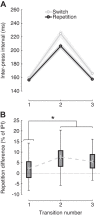Repetita iuvant: repetition facilitates online planning of sequential movements
- PMID: 32208910
- PMCID: PMC7444914
- DOI: 10.1152/jn.00054.2020
Repetita iuvant: repetition facilitates online planning of sequential movements
Abstract
Beyond being essential for long-term motor-skill development, movement repetition has immediate benefits on performance, increasing speed and accuracy of a second execution. While repetition effects have been reported for single reaching movements, it has yet to be determined whether they also occur for movement sequences, and what aspects of sequence production are improved. We addressed these questions in two behavioral experiments using a discrete sequence production (DSP) task in which human volunteers had to perform short sequences of finger movements. In experiment 1, we presented participants with randomly varying sequences and manipulated 1) whether the same sequence was repeated on successive trials and 2) whether participants had to execute the sequence (Go) or not (No-Go). We establish that sequence repetition led to immediate improvements in speed without associated accuracy costs. The largest benefit was observed in the middle part of a sequence, suggesting that sequence repetition facilitated online planning. This claim was further supported by experiment 2, in which we kept a set of sequences fixed throughout the experiment, thus allowing participants to develop sequence-specific learning: once the need for online planning decreased, the benefit of repetition disappeared. Finally, we found that repetition-related improvements only occurred for the trials that had been preceded by sequence production, suggesting that action selection and sequence preplanning may not be sufficient to reap the benefits of repetition. Together, these results show that repetition can enhance representations at the level of movement sequences (rather than of individual movements) and facilitate online planning.NEW & NOTEWORTHY Even for overlearned motor skills such as reaching, movement repetition improves performance. How brain processes associated with motor planning or execution benefit from repetition, however, remains unclear. We report the novel finding of repetition effects for sequential movements. Our results show that repetition benefits are tied to improved online planning of upcoming sequence elements. We also highlight how actual movement experience appears to be more beneficial than mental rehearsal for observing short-term repetition effects.
Keywords: motor planning; repetition effects; sequence production; skill learning.
Conflict of interest statement
No conflicts of interest, financial or otherwise, are declared by the authors.
Figures







References
Publication types
MeSH terms
LinkOut - more resources
Full Text Sources
Miscellaneous

